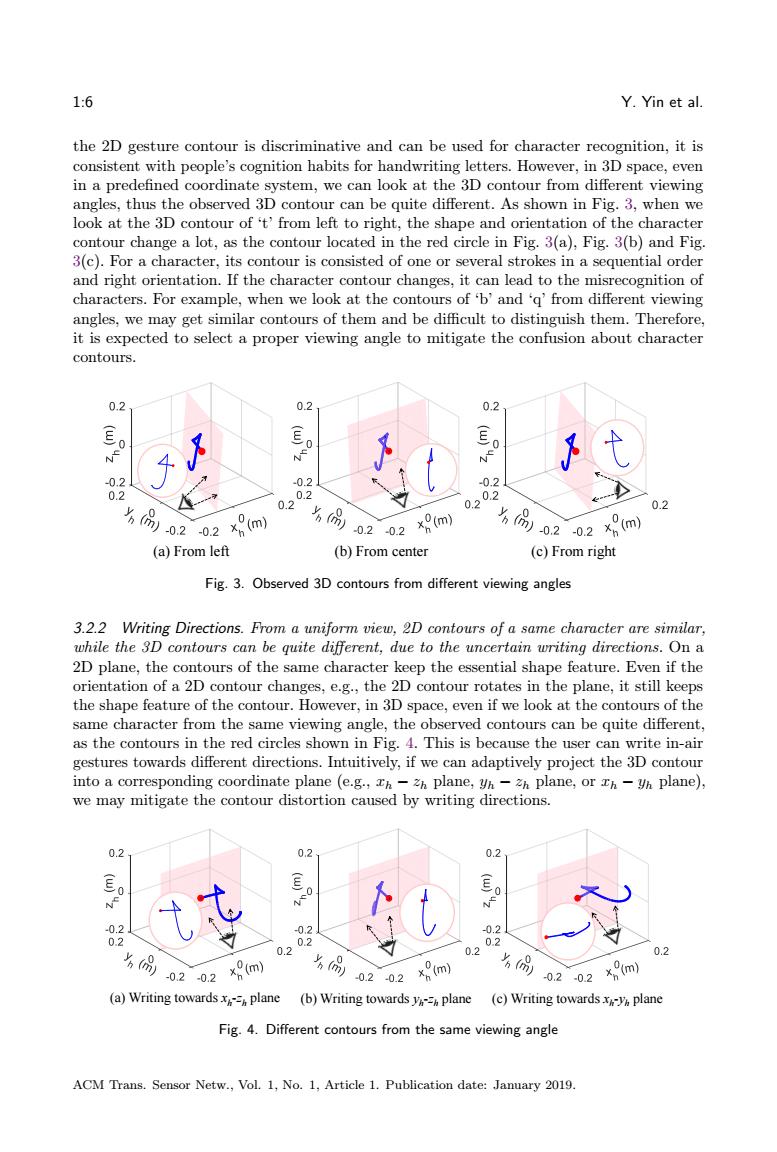正在加载图片...

1:6 Y.Yin et al. the 2D gesture contour is discriminative and can be used for character recognition,it is consistent with people's cognition habits for handwriting letters.However,in 3D space,even in a predefined coordinate system,we can look at the 3D contour from different viewing angles,thus the observed 3D contour can be quite different.As shown in Fig.3,when we look at the 3D contour of't'from left to right,the shape and orientation of the character contour change a lot,as the contour located in the red circle in Fig.3(a),Fig.3(b)and Fig. 3(c).For a character,its contour is consisted of one or several strokes in a sequential order and right orientation.If the character contour changes,it can lead to the misrecognition of characters.For example,when we look at the contours of 'b'and 'q'from different viewing angles,we may get similar contours of them and be difficult to distinguish them.Therefore, it is expected to select a proper viewing angle to mitigate the confusion about character contours. 0.2 0.2 02 N 0.2 -0.2 -0.2 0.2 0.2 0202 0.2 2m 份0202 0202 x(m) 0202x8m) (a)From left (b)From center (c)From right Fig.3.Observed 3D contours from different viewing angles 3.2.2 Writing Directions.From a uniform view,2D contours of a same character are similar, while the 3D contours can be quite different,due to the uncertain writing directions.On a 2D plane,the contours of the same character keep the essential shape feature.Even if the orientation of a 2D contour changes,e.g.,the 2D contour rotates in the plane,it still keeps the shape feature of the contour.However,in 3D space,even if we look at the contours of the same character from the same viewing angle,the observed contours can be quite different, as the contours in the red circles shown in Fig.4.This is because the user can write in-air gestures towards different directions.Intuitively,if we can adaptively project the 3D contour into a corresponding coordinate plane (e.g.,Th-Zh plane,yh-Zh plane,or Th-yh plane), we may mitigate the contour distortion caused by writing directions. 0.2 02 0.2 0.2 -02 0.2 0.2 0.2 0.2 0.2 0.2 0.2 -0.2-0.2 x(m -0.2 -0.2 (m) 020.2x9m (a)Writing towardsx plane (b)Writing towards ya plane (c)Writing towardsx-y plane Fig.4.Different contours from the same viewing angle ACM Trans.Sensor Netw.,Vol.1,No.1,Article 1.Publication date:January 2019.1:6 Y. Yin et al. the 2D gesture contour is discriminative and can be used for character recognition, it is consistent with people’s cognition habits for handwriting letters. However, in 3D space, even in a predefined coordinate system, we can look at the 3D contour from different viewing angles, thus the observed 3D contour can be quite different. As shown in Fig. 3, when we look at the 3D contour of ‘t’ from left to right, the shape and orientation of the character contour change a lot, as the contour located in the red circle in Fig. 3(a), Fig. 3(b) and Fig. 3(c). For a character, its contour is consisted of one or several strokes in a sequential order and right orientation. If the character contour changes, it can lead to the misrecognition of characters. For example, when we look at the contours of ‘b’ and ‘q’ from different viewing angles, we may get similar contours of them and be difficult to distinguish them. Therefore, it is expected to select a proper viewing angle to mitigate the confusion about character contours. (a) From left (b) From center (c) From right Fig. 3. Observed 3D contours from different viewing angles 3.2.2 Writing Directions. From a uniform view, 2D contours of a same character are similar, while the 3D contours can be quite different, due to the uncertain writing directions. On a 2D plane, the contours of the same character keep the essential shape feature. Even if the orientation of a 2D contour changes, e.g., the 2D contour rotates in the plane, it still keeps the shape feature of the contour. However, in 3D space, even if we look at the contours of the same character from the same viewing angle, the observed contours can be quite different, as the contours in the red circles shown in Fig. 4. This is because the user can write in-air gestures towards different directions. Intuitively, if we can adaptively project the 3D contour into a corresponding coordinate plane (e.g., 𝑥ℎ − 𝑧ℎ plane, 𝑦ℎ − 𝑧ℎ plane, or 𝑥ℎ − 𝑦ℎ plane), we may mitigate the contour distortion caused by writing directions. (a) Writing towards xh -zh plane (c) Writing towards xh -y (b) Writing towards y h plane h -zh plane Fig. 4. Different contours from the same viewing angle ACM Trans. Sensor Netw., Vol. 1, No. 1, Article 1. Publication date: January 2019